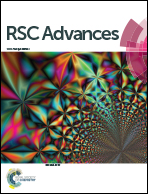Synthesis, characterization and corrosion inhibition behavior of 2-aminofluorene bis-Schiff bases in circulating cooling water†
Abstract
In this work, two new bis-Schiff bases, namely 2-bromoisophthalaldehyde-2-aminofluorene (M1) and glutaraldehyde 2-aminofluorene (M2), were synthesized, and their structures were characterized and confirmed by infrared spectroscopy, Fourier transform mass spectrometry and UV-visible spectroscopy. Their corrosion inhibition performance on carbon steel in simulated circulating cooling water was investigated by weight loss measurements and electrochemical measurements. The potentiodynamic polarization curves confirmed that two bis-Schiff bases are anode-type inhibitors; electrochemical impedance spectroscopy tests showed that M1 and M2 possess the best inhibition efficiencies of 96.25% and 99.15% at the optimal concentration of 2.50 mmol L−1, respectively. The weight loss results showed that M1 and M2 exhibit maximum ηw values of 92.62% and 96.31%, respectively. Scanning electron microscopy showed that the inhibitors inhibited carbon steel corrosion. The adsorption isotherm measurements indicated that the two inhibitors exhibited physicochemisorption mechanisms and followed Langmuir adsorption isotherms. The relationships between the molecular structure and inhibition behavior of the inhibitors were explored by density functional theory, frontier molecular orbital studies, and Fukui index analysis, which affirmed that M2 possesses higher corrosion inhibition efficiency than M1.



 Please wait while we load your content...
Please wait while we load your content...